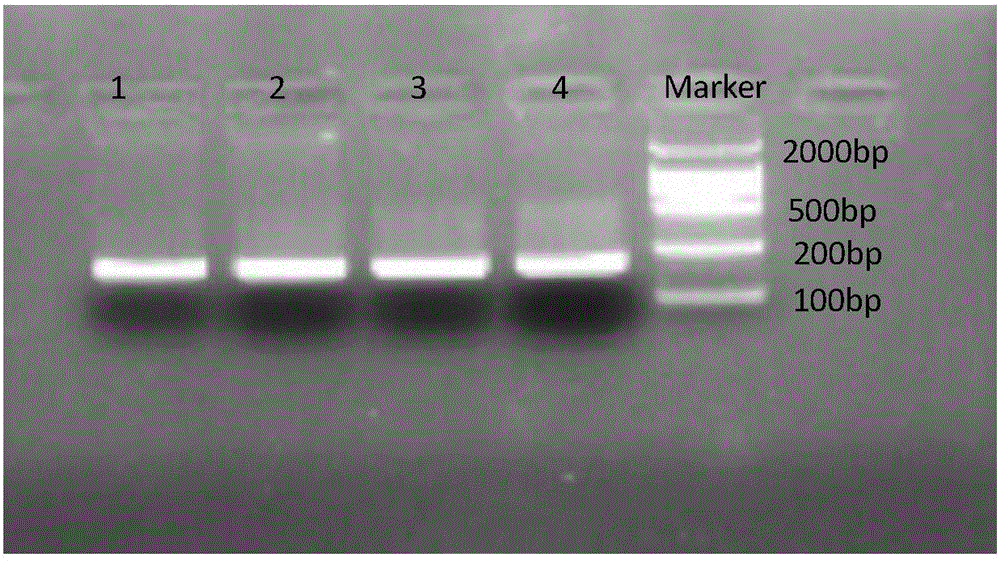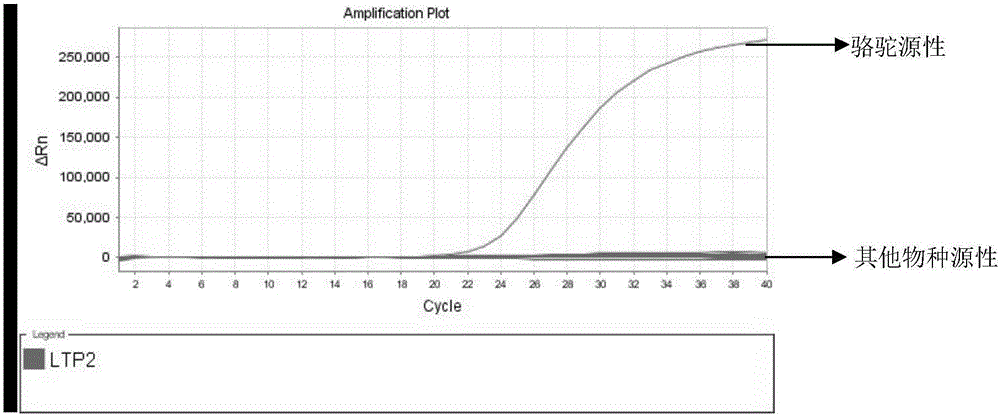Fluorogenic quantitative PCR primer, probe combination, kit and detecting method for fast identifying camel source ingredients
A source component, fluorescent quantitative technology, applied in the field of food inspection and molecular biology detection, to achieve the effect of good accuracy, simple operation and high sensitivity
- Summary
- Abstract
- Description
- Claims
- Application Information
AI Technical Summary
Problems solved by technology
Method used
Image
Examples
Embodiment 1
[0048] Obtaining of the target gene of embodiment 1
[0049] The method steps for detecting the animal origin of meat products using the kit of the present invention and the real-time fluorescent quantitative PCR detection method are as follows, and can detect whether various meat samples to be tested contain camel-derived components:
[0050] DNA extraction: Take 50g of the sample to be tested, grind it and mix it thoroughly. The sample to be tested can be animal skin, hair, organ tissue and muscle. Take 50mg to extract DNA. Animal tissue extraction kits can be used to extract DNA, and classic hand-held methods can also be used (see Molecular Cloning Handbook Animal Tissue DNA Extraction Methods). The Nanodrop nucleic acid detector detects the concentration and purity of the DNA sample, which requires 1-20ng / μl, and the OD value is between 1.7-2.0.
[0051] The acquisition of the camel target gene: using the extracted camel-derived genome as a template, carry out ordinary PC...
Embodiment 2
[0052] The real-time fluorescent PCR amplification of embodiment 2 test sample DNA
[0053] This kit includes: PCR buffer, MgCl 2 Reaction mixture with dNTPs (2×TaqManMasterMix), ultrapure water, camel primers for highly specific amplification, TaqMan probe mixture (0.4~1μM)
[0054] Prepare in the PCR reaction tube according to the reaction system of the kit in Table 1, put the PCR reaction tube into the fluorescent quantitative PCR instrument, and complete the PCR amplification according to the following reaction conditions: Amplification program: pre-denaturation at 95°C for 10 min; denaturation at 95°C for 10 s , annealing at 60° C. for 35 s (where fluorescence signals are collected), 40 cycles.
[0055] For the real-time fluorescent quantitative PCR amplification reaction system of the present invention, when it is a 20 μL reaction system, its preferred configuration is shown in Table 2.
[0056] Table 2 Fluorescent quantitative PCR reaction system
[0057]
[0058]...
Embodiment 4
[0068] The sensitivity test of embodiment 4 methodological verification
[0069] Genomic DNA Sensitivity Test
[0070] According to the kit used in Example 2, the target genomic DNA was extracted, quantified to 5ng by Nanodrop, and diluted to 0.5ng / μL, 0.05ng / μL, 0.005ng / μL, 0.0005ng / μL, 0.00005ng / μL, , 2 μl was taken as the template amount for each gradient, and the camel DNA was detected according to the above method to investigate the sensitivity of the kit.
[0071] The results show( Figure 4 ), when the amount of fluorescent quantitative template DNA is 0.001ng, the probe still has an amplification curve and the Ct value is <35; but when the template amount is 0.0001ng, the Ct value is more than 35, and there is basically no amplification curve, so the kit’s The detection limit was 0.001ng.
PUM
 Login to View More
Login to View More Abstract
Description
Claims
Application Information
 Login to View More
Login to View More - R&D
- Intellectual Property
- Life Sciences
- Materials
- Tech Scout
- Unparalleled Data Quality
- Higher Quality Content
- 60% Fewer Hallucinations
Browse by: Latest US Patents, China's latest patents, Technical Efficacy Thesaurus, Application Domain, Technology Topic, Popular Technical Reports.
© 2025 PatSnap. All rights reserved.Legal|Privacy policy|Modern Slavery Act Transparency Statement|Sitemap|About US| Contact US: help@patsnap.com



